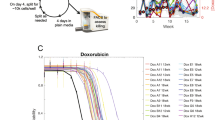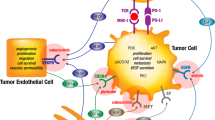Abstract
The acquisition of drug-resistant tumour cells is the main problem in the medical treatment of a range of malignant diseases. In recent years, three new classes of anti-cancer agents, each with a novel mechanism of action, have been brought forward to clinical trials. These are the topoisomerase I (topo I) poisons topotecan and irinotecan, which are both camptothecin derivatives, the taxane tubulin stabilizers taxol and taxotere and, finally, the antimetabolite gemcitabin, which is active in solid tumours. The process of optimizing their use in a combination with established agents is very complex, with numerous possible drug and schedule regimens. We describe here how a broad panel of drug-resistant small-cell lung cancer (SCLC) cell lines can be used as a model of tumour heterogeneity to aid in the selection of non-cross-resistant regimens. We have selected low-fold (3-10x) drug-resistant sublines from a classic (NCI-H69) and a variant (OC-NYH) SCLC cell line. The resistant cell lines include two sublines with different phenotypes towards alkylating agents (H69/BCNU and NYH/CIS), two sublines with different phenotypes against topo I poisons (NYH/CAM and NYH/TPT) and three multidrug resistant (MDR) sublines (H69/DAU, NYH/VM, and H69/VP) with combinations of mdr1 and MRP overexpression as well as topoisomerase II (topo II) down-regulation or mutation. Sensitivity to 20 established and new agents was measured in a standardized clonogenic assay. Resistance was highly drug specific. Thus, none of the cell lines was resistant to all drugs. In fact, all resistant cell lines exhibited patterns of collateral sensitivity to various different classes of drugs. The most intriguing pattern was collateral sensitivity to gemcitabin in two cell lines and to ara-C in five drug-resistant cell lines, i.e. in all lines except the lines resistant to topo I poisons. Next, all sensitivity patterns in the nine cell lines were compared by correlation analysis. A high correlation coefficient (CC) for a given pair of compounds indicates a similar pattern in response in the set of cell lines. Such data corroborate the view that there is cross-resistance among the drugs. A numerically low coefficient indicates that the two drugs are acting in different ways, suggesting a lack of cross-resistance between the drugs, and a negative correlation coefficient implies that two drugs exhibit collateral sensitivity. The most negative CCs (%) to the new drug leads were: taxotere-carmustine (BCNU) (-75), taxol-cisplatin (-58), ara-C-taxol (-25), gemcitabin-doxorubicin (-32), camptotecin-VM26 (-41) and topotecan-VP16 (-17). The most negative correlations to the clinically important agent VP-16 were: cisplatin (-70); BCNU (-68); camptothecin (-38); bleomycin (-33), gemcitabin (-32); ara-C (-21); topotecan (-17); melphalan (-3); and to the other main drug in SCLC treatment cisplatin were: doxorubicin (-70); VP-16 (-70); VM-26 (-69); mAMSA (-64); taxotere (-58); taxol (-58). Taxol and taxotere were highly correlated (cross-resistant) to VP-16 (0.76 and 0.81 respectively) and inversely correlated to cisplatin (both -0.58). Similarly, camptothecin and topotecan were correlated to cisplatin but inversely correlated to VP-16 and other topo II poisons. From the sensitivity data, we conclude that collateral sensitivity and lack of cross-resistance favours a cisplatin-taxane or topo I-topo II poison combination, whereas patterns of cross-resistance suggest that epipodophyllotoxin-taxane or topo I poison-cisplatin combinations may be disadvantageous.
This is a preview of subscription content, access via your institution
Access options
Subscribe to this journal
Receive 24 print issues and online access
$259.00 per year
only $10.79 per issue
Buy this article
- Purchase on Springer Link
- Instant access to full article PDF
Prices may be subject to local taxes which are calculated during checkout
Similar content being viewed by others
Author information
Authors and Affiliations
Rights and permissions
About this article
Cite this article
Jensen, P., Holm, B., Sorensen, M. et al. In vitro cross-resistance and collateral sensitivity in seven resistant small-cell lung cancer cell lines: preclinical identification of suitable drug partners to taxotere, taxol, topotecan and gemcitabin. Br J Cancer 75, 869–877 (1997). https://doi.org/10.1038/bjc.1997.154
Issue Date:
DOI: https://doi.org/10.1038/bjc.1997.154
This article is cited by
-
Medicinal plants and phytochemicals against multidrug-resistant tumor cells expressing ABCB1, ABCG2, or ABCB5: a synopsis of 2 decades
Phytochemistry Reviews (2021)
-
New insights from the widening homogeneity perspective to target intratumor heterogeneity
Cancer Communications (2018)
-
Combination of paclitaxel thermal gel depot with temozolomide and radiotherapy significantly prolongs survival in an experimental rodent glioma model
Journal of Neuro-Oncology (2013)
-
Distinct genetic alterations occur in ovarian tumor cells selected for combined resistance to carboplatin and docetaxel
Journal of Ovarian Research (2012)
-
Activity of topotecan given intravenously for 5 days every three weeks in patients with advanced non-small cell lung cancer pretreated with platinum and taxanes: a phase II study
Investigational New Drugs (2011)



